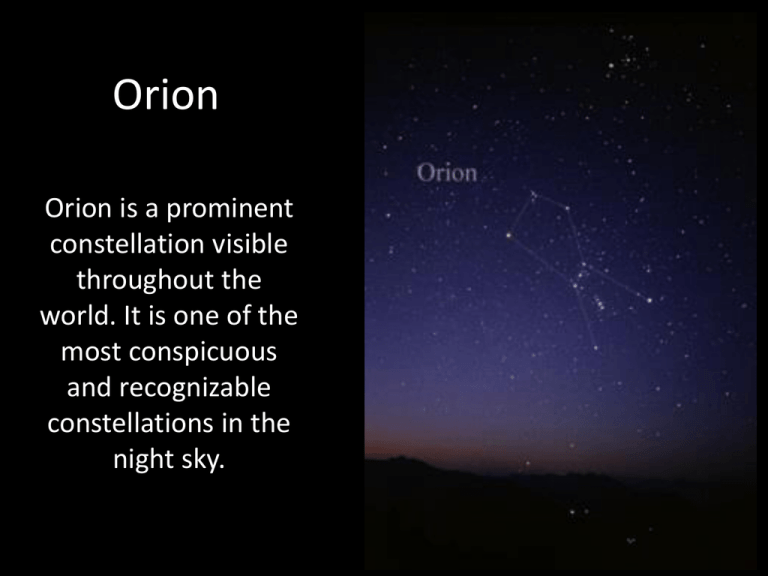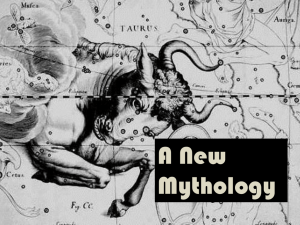Orion - FISD
advertisement

Orion Orion is a prominent constellation visible throughout the world. It is one of the most conspicuous and recognizable constellations in the night sky. It was named after Orion, a hunter in Greek mythology. Its brightest stars are Rigel and Betelgeuse, a blue-white and a red supergiant, respectively. • The earliest depiction that has been linked to the constellation of Orion is a prehistoric mammoth ivory carving found in a cave in the Ach valley in Germany in 1979. • Archaeologists have estimated it to have been fashioned approximately 32,000 to 38,000 years ago • Orion is most visible in the evening sky from January to March. • In the period May–July, Orion is in the daytime sky and thus not visible at most latitudes. Navigational aid Orion is very useful as an aid to locating other stars. By extending the line of the Belt southeastward, Sirius can be found; northwestward, Aldebaran. A line eastward across the two shoulders indicates the direction of Procyon. A line from Rigel through Betelgeuse points to Castor and Pollux. Orion's seven brightest stars form a distinctive hourglass-shaped asterism, or pattern, in the night sky. Four stars—Rigel, Betelgeuse, Bellatrix and Saiph— form a large roughly rectangular shape, in the center of which lie the three stars of Orion's Belt. Coincidentally, these seven stars are among the most distant that can easily be seen with the naked eye. Descending from the 'belt' is a smaller line of three stars (the middle of which is in fact not a star but the Orion Nebula), known as the hunter's 'sword'. • Many of the stars are luminous hot blue supergiants. • Standing out by its red hue is Betelgeuse. Stars • Betelgeuse is a massive M-type red supergiant star nearing the end of its life. • It serves as the "right shoulder" of the hunter it represents (assuming that he is facing the observer), and is the eighth brightest star in the night sky. • Rigel is a B-type blue supergiant that is the sixth brightest star in the night sky. Rigel will pass its supergiant stage soon, either collapsing in the case of a supernova or shedding its outer layers and turning into a white dwarf. It serves as the left foot of Orion, the hunter. • Bellatrix is the twenty-seventh brightest star in the night sky. It is considered a B-type blue giant, though it is too small to explode in a supernova. Bellatrix serves as Orion's left shoulder. • Saiph serves as Orion's right foot. It is of a similar distance and size to Rigel. Orion's Belt or The Belt of Orion is an asterism within the constellation. Asterism • It consists of the three bright stars Zeta (Alnitak), Epsilon (Alnilam), and Delta (Mintaka). Alnitak is around 800 light years away from earth and is 100,000 times more luminous than the Sun. • Alnilam is approximately 1,340 light years away from Earth, shines with magnitude 1.70 • Mintaka is 915 light years away and shines with magnitude 2.21. Meteor showers • Around October 20th each year the Orionid meteor shower (Orionids) reaches its peak. As many as 20 meteors per hour can be seen. • The Orionids are so-called because the point they appear to come from lies in the constellation Orion, but they can be seen over a large area of the sky. Orionids last approximately one week. In some years, meteors may occur at rates of 50-70 per hour. Deep-sky objects Hanging from Orion's belt is his sword, consisting of three stars, called the Trapezium and the Orion Nebula (M42). This is a spectacular object that can be clearly identified with the naked eye as something other than a star. Using binoculars, its clouds of nascent stars, luminous gas, and dust can be observed. Orion Nebula (M42) HST image M78 (NGC 2068) is a nebula in Orion. With an overall magnitude of 8.0, it is significantly dimmer than the Great Orion Nebula that lies to its south; however, it is at approximately the same distance, at 1,600 light-years from Earth. It can easily be mistaken for a comet in the eyepiece of a telescope. Spitzer image Another famous nebula is IC 434, the Horsehead Nebula. It contains a dark dust cloud whose shape gives the nebula its name. NGC 2174 (also known as Monkey Head Nebula) is an emission nebula located in the constellation Orion. It is thought to be located about 6,400 light-years away from Earth. Major Stars Proper Name Solar Radii Apparent Magnitude ~Distance (L Yrs) Betelgeuse 667 0.43 643 Rigel 78 0.18 772 Bellatrix 7.0 1.62 243 Mintaka ? Alnilam 26 1.68 1,359 Alnitak 20 1.70/~4/4.21 800 Saiph 11 2.06 724 2.23 (3.2/3.3) / 6.85 / 14.0 900 Legends and Cultures The distinctive pattern of Orion has been recognized in numerous cultures around the world, and many myths have been associated with it. It has also been used as a symbol in the modern world. Babylonia • The Babylonian star catalogues of the Late Bronze Age name Orion MULSIPA.ZI.AN.NA, "The Heavenly Shepherd" or "True Shepherd of Anu" - Anu being the chief god of the heavenly realms. Egyptian • In ancient Egypt, the stars of Orion were regarded as a god, called Sah. • In the Pyramid Texts, from the 24th and 23rd centuries BC, Sah was one of many gods whose form the dead pharaoh was said to take in the afterlife. • The Armenians identified their legendary patriarch and founder Hayk with Orion. Hayk is also the name of the Orion constellation in the Armenian translation of the Bible. The Bible mentions Orion three times: • Job 9:9 ("He is the maker of the Bear and Orion"), • Job 38:31 ("Can you loosen Orion's belt?"), and • Amos 5:8 ("He who made the Pleiades and Orion"). Greco-Roman antiquity • Orion's current name derives from Greek mythology, in which Orion was a gigantic, supernaturally strong hunter of ancient times. Son of Poseidon (Neptune), god of the sea in the GraecoRoman tradition One myth recounts Gaia's rage at Orion, who dared to say that he would kill every animal on the planet. The angry goddess tried to dispatch Orion with a scorpion. This is given as the reason that the constellations of Scorpius and Orion are never in the sky at the same time. However, Ophiuchus, the Serpent Bearer, revived Orion with an antidote. This is said to be the reason that the constellation of Ophiuchus stands midway between the Scorpion and the Hunter in the sky. Middle East • In medieval Muslim astronomy, Orion was known as al-jabbar, "the giant". Orion's sixth brightest star, Saiph, is named from the Arabic, saif al-jabbar, meaning "sword of the giant". East Asian antiquity • In China, Orion was one of the 28 lunar mansions. It is known as Shen (參), literally meaning "three", for the stars of Orion's Belt. European folklore • In old Hungarian tradition, "Orion" is known as (magic) Archer or Reaper. In recently rediscovered myths he is called Nimrod, the greatest hunter, father of the twins. In other Hungarian traditions, "Orion's belt" is known as "Judge's stick“. Americas • The Seri people of northwestern Mexico call the three stars in the belt of Orion Hapj (a name denoting a hunter) which consists of three stars: Hap (mule deer), Haamoja (pronghorn), and Mojet (bighorn sheep). Hap is in the middle and has been shot by the hunter; its blood has dripped onto Tiburón Island. • The same three stars are known in Spain and most of Latin America as "Las tres Marías" (Spanish for "The Three Marys"). In Puerto Rico, the three stars are known as the "Los Tres Reyes Magos" (Spanish for The three Wise Men). • The Chippewa Native Americans call this constellation Kabibona'kan, the Winter Maker, as its presence in the night sky heralds winter. • To the Lakota Native Americans, Tayamnicankhu (Orion’s Belt) is the spine of a bison. The great rectangle of Orion are the bison's ribs; the Pleiades star cluster in nearby Taurus is the bison’s head; and Sirius in Canis Major, known as Tayamnisinte, is its tail. Contemporary symbolism • The imagery of the belt and sword has found its way into popular western culture, for example in the form of the shoulder insignia of the 27th Infantry Division of the United States Army during both World Wars, probably owing to a pun on the name of the division's first commander, Major General John F. O'Ryan. NASA • The Orion Multi-Purpose Crew Vehicle (MPCV) is a spacecraft built to take humans farther than they’ve ever gone before. Orion will serve as the exploration vehicle that will carry the crew to space and provide safe re-entry from deep space return velocities. • On December 5, 2014, Orion launched atop a Delta IV Heavy rocket for a two-orbit, four-hour test flight. In the future, Orion will launch on NASA’s new heavylift rocket, the Space Launch System. More powerful than any rocket ever built, SLS will be capable of sending humans to deep space destinations such as an asteroid and eventually Mars. The End







